The Apple iPhone 6s and iPhone 6s Plus Review
by Ryan Smith & Joshua Ho on November 2, 2015 8:00 AM EST- Posted in
- Smartphones
- Apple
- Mobile
- SoCs
- iPhone 6s
- iPhone 6s Plus
Display
In pretty much any smartphone, displays are going to be one of the most important aspects of the user experience. If a display is dim or has a highly reflective display it will be unreadable outdoors. If the contrast is low, the display can become difficult to read and not particularly appealing to the eye. Other issues like lack of color stability and contrast stability with changes in viewing angles will be much more noticeable than on something like a laptop or desktop where the monitor is usually kept at a constant position in space relative to the eye. In order to evaluate these factors we use both relative comparisons and absolute measurements. Although the human eye is sufficient for relative comparison, for absolute measurements we use X-Rite’s i1Pro2 spectrophotometer for precise color and luminance measurements, along with X-Rite’s i1Display Pro colorimeter for accurate contrast figures. Hardware alone is insufficient for collecting and presenting data, so we also use SpectraCal’s CalMAN 5 with a custom workflow, which allows for collecting and presenting data in a readable manner.
In the case of the iPhone 6s and iPhone 6s Plus, the display appears to be effectively unchanged from the iPhone 6 and iPhone 6 Plus. The iPhone 6s retains the 1334x750 resolution of the previous variant, and the iPhone 6s Plus has the same 1080p resolution as well. Apple continues to use the same M2 scaler as well, which means that although the display’s physical resolution is 1080p Apple is actually rendering the display at 2208x1242 and scaling it to fit the display. The resolution of the iPhone 6s is on the low side relative to most Android devices, which is noticeable but the pixel density is sufficient to avoid any obvious problems here.
As with the iPhone 6, both the iPhone 6s and 6s Plus use dual domain pixels, which make the subpixels look more like chevrons under a microscope. This improves viewing angles by reducing the amount of color shifting that occurs when the display viewing angle is changed. As far as I can tell, Apple continues to be one of the few OEMs that pulls this off effectively. Although contrast and luminance aren’t perfectly consistent with changes in viewing angles, it basically looks like the display is painted underneath the glass. The iPhone 6s Plus does a better job at pulling off this illusion as the higher pixel density helps to eliminate some of the fuzziness or pixilation that might otherwise occur. Samsung gets close here, but for whatever reason ambient light causes noticeable interference effects and in general there’s noticeable color shift when moving the display around. Weirdly enough, the OEM that seems to be doing the best job here continues to be HTC with the One M9+.

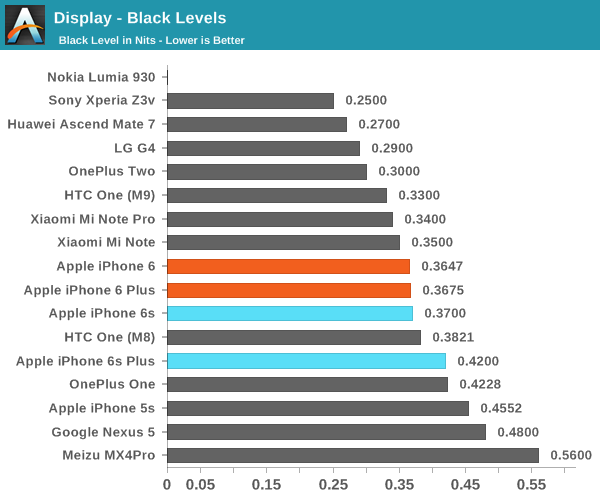
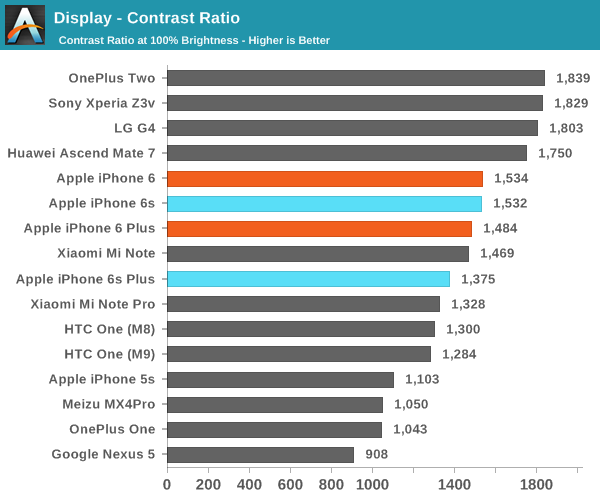
Moving on to our usual brightness and contrast testing, it looks like Apple has improved the maximum brightness of their displays with the use of the new LED backlight driver, but it’s important to note that in the case of the iPhone 6s, the maximum brightness isn’t constant. The behavior is relatively subtle, but with iOS 9 at maximum brightness the display brightness steadily lowers over the course of an hour by about 10 nits maximum. It looks like this effect tails off in both the rate of luminance decrease and overall luminance decrease as peak brightness approaches 500 nits, where the effect appears to be non-existent. It’s likely that this behavior is designed to reduce the battery impact of keeping the display at maximum brightness in all situations. Either way, peak luminance is high enough that it isn’t a struggle to read the display outdoors and contrast in low-light conditions also remains high due to the use of photo-alignment in the liquid crystal layer which helps to make the liquid crystals stay in the right shape.
iPhone 6s
iPhone 6s Plus

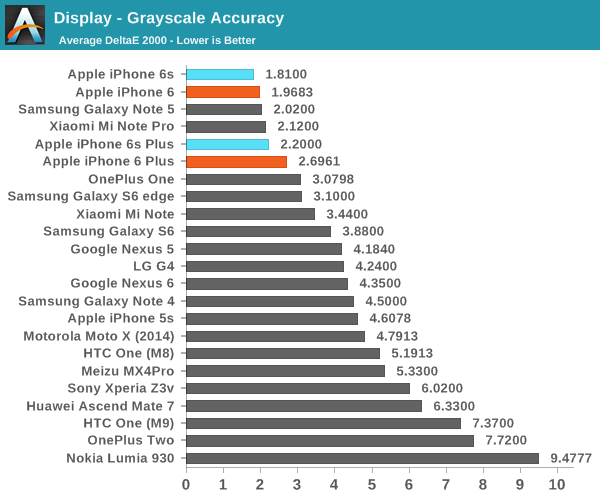
In grayscale, we don’t quite see the near-perfect white balance we saw last year but gamma remains almost impeccable when compared to the industry standard power 2.2 gamma. I suspect that the units we received this time are closer to the mean for white balance compared to last year, as in general due to the blue LED backlights used in most LCDs a colder color balance will generally require less power to display than a warmer one.
iPhone 6s
iPhone 6s Plus

In our saturation sweep testing, the iPhone 6s and 6s Plus both continue to track closely to expected values for sRGB, which is the current industry standard color gamut. I don’t really have any criticism here. The previous iPhone’s displays were of similar caliber, so this is pretty much par for the course if you’re used to iPhone displays.
iPhone 6s
iPhone 6s Plus
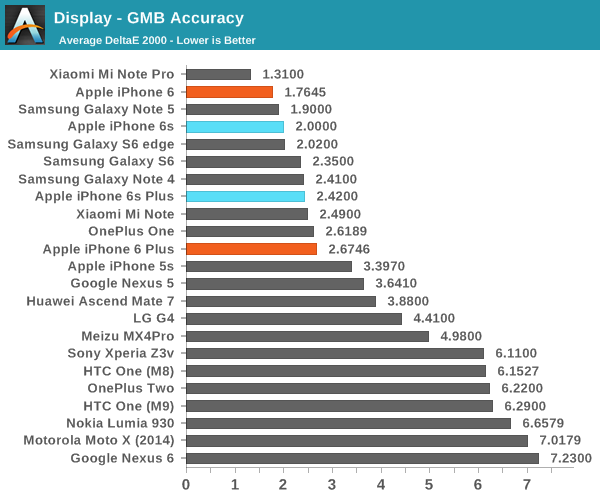
Similarly in the GMB ColorChecker, the iPhone 6s and 6s Plus both pass with flying colors. If you’re using an iPhone 6s or 6s Plus for any remotely color-critical work like viewing and/or editing photos and videos, it’s a pretty fair bet that you’ll be able to rely on these phones to provide an accurate color reproduction in pretty much any condition. Samsung does provide better contrast and the possibility of extra color saturation with their Galaxy S6 and Note 5, but this comes at the cost of potential for burn-in, increased power consumption in certain scenarios, and increased distortion with changes in viewing angles. I think this means that it basically comes out to a wash, but depending upon personal taste one may prove to be better than another.



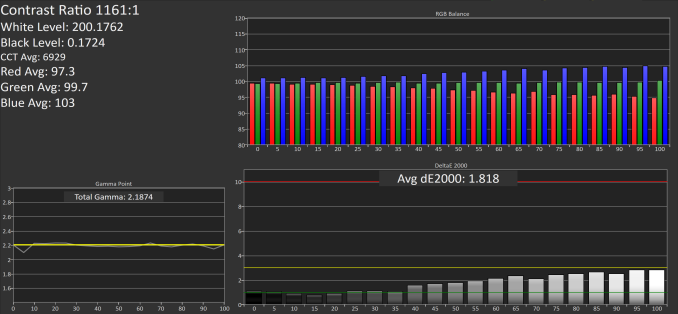
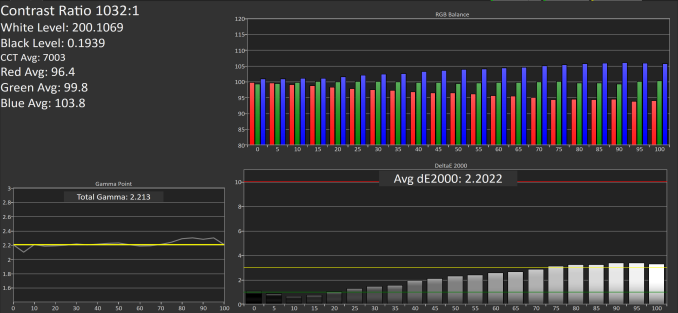
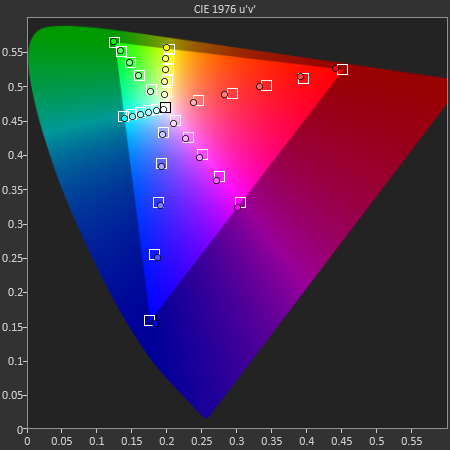
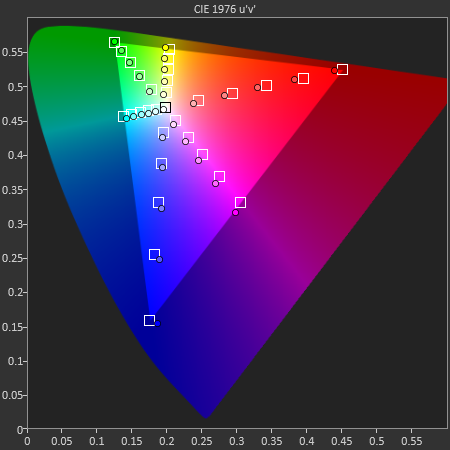
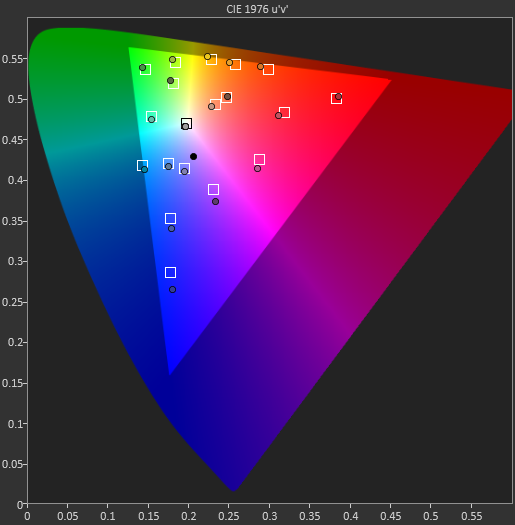
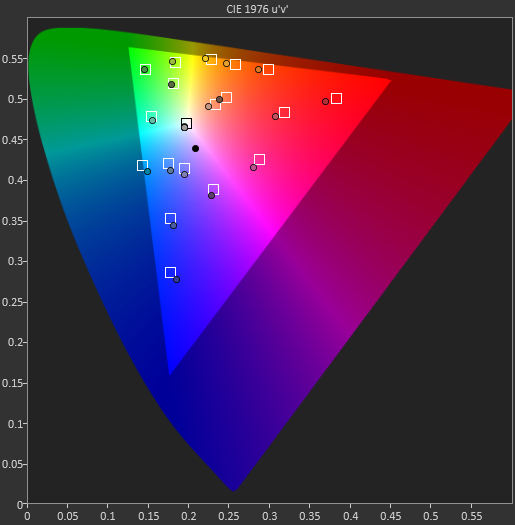








531 Comments
View All Comments
Mummiez - Saturday, December 26, 2015 - link
There is also a video on YouTube showing a dancing man wearing a horse mask. Even more amusingly, I must add.https://www.youtube.com/watch?v=ffDPTKn7HiY
mike3332015 - Saturday, November 7, 2015 - link
if this gets the second highest award then can someone tell me what got the first highest award?TechnologyGuy - Saturday, November 7, 2015 - link
Good review but as many have pointed out, as is customary at Anand, very biased in favor of Apple products. Over-reaching statements are used throughout the article and the conclusions simply don't follow from the evidence. No doubt the 6s is one of the top smartphones on today's market but it lags in camera performance (Z5, S6, G4, P6 are all better) and the poor screen is simply unacceptable by today's standards (no, the dpi is high enough argument holds no water; at least for me I can tell at a first glance when compared to other phones). Software is of course more subjective and for normal usage, there is no clear winner between iOS and Android. Stability is non-argument as I have had far more issues on my iPhones than my Galaxy S6, not to mention having to fix my GF's phone after iOS 9 bricked it. Lack of customization in iOS (short of jailbreaking which is still limiting) is also a deal-breaker for those of us who care.So is it a good phone? Sure I'd agree. But it's far from the leaders in the market today and to claim such is simply false.
ciderrules - Saturday, November 7, 2015 - link
Yet another person upset at the cold, hard, fact that Apple is killing it with fantastic hardware.TechnologyGuy - Sunday, November 8, 2015 - link
Fantastic hardware? I guess you didn't even read my comment. The SoC is a very nice engineering achievement but it does nothing to alter my user experience as a power user. The features I personally require are simply subpar in today's flagship market (camera & screen as I have clearly pointed out).There is nothing to be upset about - Apple has come up with a very nice product that fits well into the top end of the market but there is no question it misses the mark in several areas, at least for users like myself. I am more disappointed in the biased nature of the review than the actual product.
ciderrules - Sunday, November 8, 2015 - link
Power user? iOS users are the true power users as they actually can choose from high-end software to do real work on their devices. Or do you think widgets or minor customization makes you a power user?Oh, and saying Anand is biased? Typical response from people who dislike Apple and are having trouble trying to accept they make the best smartphone.
TechnologyGuy - Monday, November 9, 2015 - link
Why would I accept that Apple makes the best smartphone when the company does not? Blind favoritism serves no purpose in the tech world. For that matter, I do not think any company makes the "best" products. Such a term is irrelevant and frankly counter productive. I expect Anand and its readers to be more discerning than that. Or perhaps I am wrong.I have owned and still own several Apple products. Are they definitively superior to their competitors? No, they are not, but they serve their purpose, as any adequate or premium technology product should.
I have no doubt that some developers have chosen the iOS ecosystem for specialized applications; however, those are not relevant to my needs. As I pointed out very clearly, I have very specific requirements which the iPhone 6s has not met. I am simply pointing out the biases in this review. If it meets your needs, great, then I guess you are one happy customer.
As a former computer/electrical engineer who specialized in signal processing, I need no one to tell me a what a power user is, nor would I be inclined to respond further unless there is some valid, well-constructed points to be discussed.
Samus - Saturday, November 7, 2015 - link
11MB cache on a mobile SOC? Damn!?zeeBomb - Sunday, November 8, 2015 - link
Damnnnn!Zoidberg - Saturday, November 7, 2015 - link
Even for AT this is laughable... no mention of the fact that Plus is 25% heavier with a smaller screen and battery than Edge+. Fanboys or sellouts?